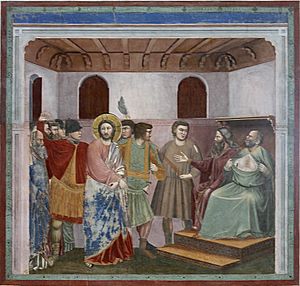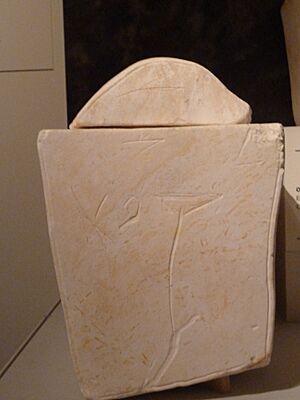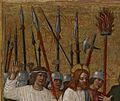Caiaphas facts for kids

Caiaphas (born around 14 BC, died around 46 AD) was an important Jewish high priest during the time Jesus lived. He is well-known from the New Testament in the Bible.
According to the Gospels of Matthew, Luke, and John, Caiaphas was involved in the plan to have Jesus killed. He was also the leader during Jesus' trial before the Sanhedrin, which was a Jewish court.
The main information we have about Caiaphas comes from the New Testament and the writings of a Jewish historian named Josephus. Josephus tells us that a Roman governor named Valerius Gratus made Caiaphas the high priest.
Contents
What's in a Name?
The name Caiaphas might come from a few different words:
- It could mean 'basket maker' in Aramaic.
- It might also relate to a word meaning 'head' or 'chief' in Greek.
- Some think it could mean "as comely" in Aramaic.
- Or even "a dell" or "depression" in Akkadian.
Stories About Caiaphas
In the New Testament

Caiaphas's father-in-law, Annas, was also a high priest before him. Annas still had a lot of power and influence. Caiaphas was high priest for a long time, about 18 years. This suggests he had a good relationship with the Roman leaders who ruled the area.
In the Gospel of John, the high priests, including Caiaphas, gathered the Sanhedrin (the Jewish court) because Jesus was becoming very popular, especially after he raised Lazarus from the dead. They worried that if Jesus continued, everyone would believe in him. They feared this would make the Romans angry, and the Romans might then destroy their holy place and their nation.
Caiaphas made a decision he thought was best for everyone. He suggested it would be better for "one man" (Jesus) to die than for the whole nation to be destroyed. The Bible says that because he was the high priest that year, he was actually prophesying that Jesus would die for the nation.
Afterward, Jesus was taken to Pontius Pilate, the Roman governor. Pilate told the priests to judge Jesus themselves. But they said they didn't have the power to put someone to death. Pilate questioned Jesus but found no reason to charge him. Pilate then offered the crowd a choice to release one prisoner, as was a tradition during Passover. The crowd chose a criminal named Barabbas instead of Jesus.
Jesus' Trial
In the Gospel of Matthew, Caiaphas and other members of the Sanhedrin questioned Jesus. They were looking for a reason to convict him, but they couldn't find any. Jesus remained silent until Caiaphas demanded to know if Jesus was the Christ (the Messiah). Jesus replied that they would see him "seated at the right hand of power, and coming on the clouds of heaven." Caiaphas and the others then accused him of blasphemy (speaking disrespectfully about God). They decided he deserved punishment.
Peter and John Speak Out
Later, in the book of Acts, Peter and John were brought before Annas and Caiaphas. This happened after they healed a crippled beggar. Caiaphas and Annas questioned how they had done this miracle. Peter, filled with the Holy Spirit, explained that Jesus of Nazareth was the source of their power. Caiaphas and the other priests were surprised because Peter and John had no formal education, yet they spoke so powerfully.
Caiaphas sent the apostles away. He and the other priests agreed that the news of the miracle had spread too widely to deny it. Instead, they decided to warn the apostles not to speak about Jesus anymore. However, Peter and John refused, saying they must obey God rather than them.
Josephus's Account
Josephus was a Jewish historian who lived in the 1st century. He is a very important source of information about Caiaphas outside of the Bible. Josephus wrote that Caiaphas became high priest during a difficult time. He also recorded that a Roman official named Lucius Vitellius the Elder later removed Caiaphas from his position.
Josephus states that Caiaphas was appointed high priest in 18 AD by the Roman governor Valerius Gratus. Caiaphas was the son-in-law of Annas, who was also a high priest. Annas had five sons who also served as high priests after him. Caiaphas's time as high priest was one of the longest during that period.
Finding Caiaphas's Tomb

In 1990, workers found an ornate limestone box called an ossuary while building a road in Jerusalem. This box was very old and contained human bones. An inscription on the side seemed to say "Joseph son of Caiaphas." Because of this, many believed the bones belonged to the High Priest Caiaphas.
However, some experts have questioned this. They point out things like the exact spelling of the name, the fact that it doesn't mention him being a high priest, and that the tomb itself was quite plain.
In 2011, archaeologists found another ossuary that had been stolen from a tomb. It had the inscription: "Miriam, daughter of Yeshua, son of Caiaphas, Priest of Ma’aziah from Beth ‘Imri." This discovery helped connect Caiaphas to a specific priestly family group.
Caiaphas in Books and Art
In Literature
Caiaphas appears in different stories and poems. In a French text from the 1200s, he is shown imprisoning Joseph of Arimathea. In Dante Alighieri's famous poem Inferno, Caiaphas is placed in a special part of Hell where hypocrites are punished. He is shown being crucified on the ground, and other hypocrites walk over him.
Caiaphas is also mentioned in Oscar Wilde's poem The Ballad of Reading Gaol. He also appears in the novel The Master and Margarita by Mikhail Bulgakov, where he argues with Pontius Pilate about Jesus' death sentence.
In Art
Many artists have painted scenes involving Caiaphas, especially "Christ Before Caiaphas." These paintings often show the dramatic moment of Jesus' trial.
-
Christ Before Caiaphas, by Antonio della Corna. Now at the Walters Art Museum.
-
Christ Before the High Priest, by Gerard van Honthorst. Now at the National Gallery.
In Movies
Caiaphas has been played by many actors in films and TV shows about Jesus. Some of these actors include:
- Rudolph Schildkraut in King of Kings (1927)
- Martin Landau in The Greatest Story Ever Told (1965)
- Bob Bingham in Jesus Christ Superstar (1973)
- Anthony Quinn in Jesus of Nazareth (1977)
- Mattia Sbragia in The Passion of the Christ (2004)
- Adrian Schiller in The Bible (2013) and Son of God (2014)
- Rufus Sewell in Killing Jesus (2015)
See also
 In Spanish: Caifás para niños
In Spanish: Caifás para niños
- List of biblical figures identified in extra-biblical sources
- Aristobulus III of Judea - Another high priest from an important family.



